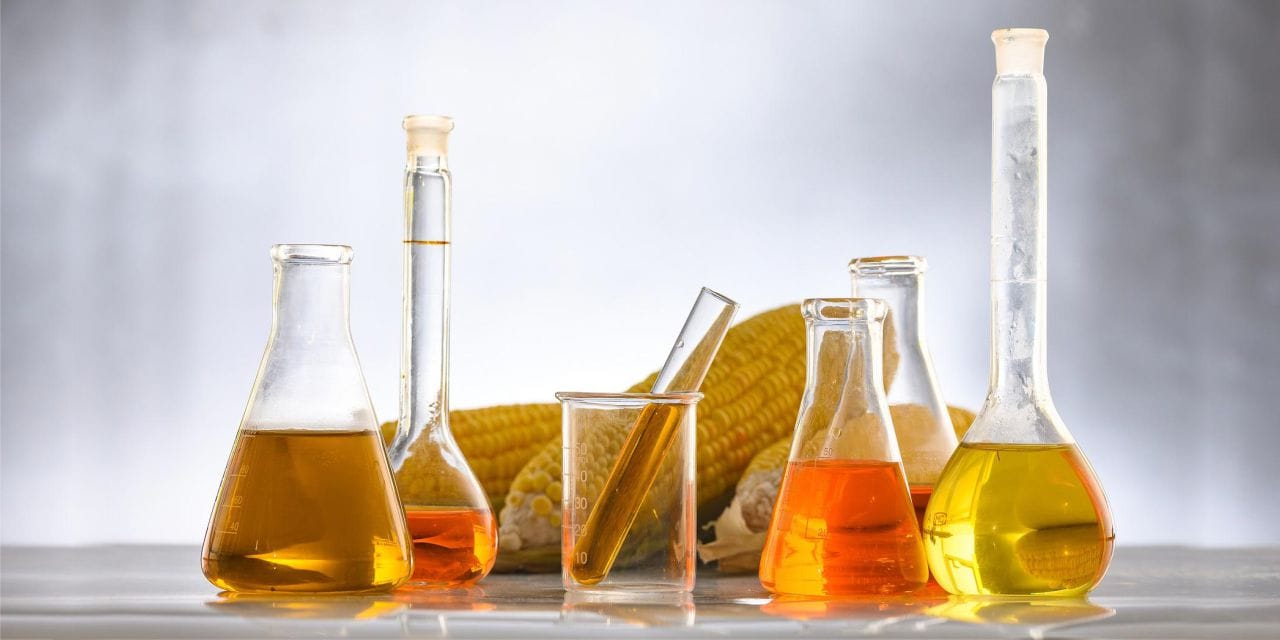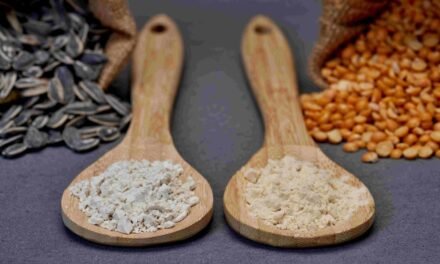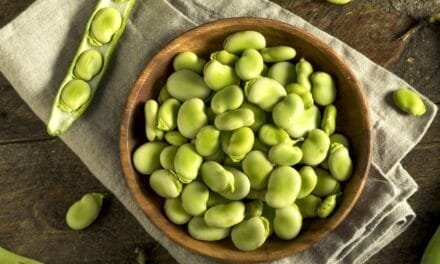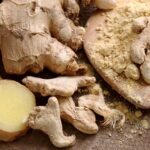Pullulanase is a very potent enzyme for the degradation of starch to glucose or maltose. This enzyme is used mainly in the glucose and maltose syrup industries. The agricultural wastes rich in polysaccharides can be processed into useful form such as sucrose and glucose instead of dumping, explain Sunita Yadava, Abhishek Dutt Tripathi, Arpit Srivastavaa, and S.K. Srivastva.
What is Pullulanase Enzyme?
Pullulanase (pullulan 6-glucanohydrolase, EC 3.2.1.41) is an enzyme which is capable of hydrolyzing the a-l, 6-glucosidic linkages of pullulan and produces maltotriose as the end product (Abdullah and French, 1970).
Pullulan is a polymer synthesised by the yeast-like fungus Aureobasidium pullulans. It is a linear a-D-glucan built of maltotriose subunits (Abdullah and French, 1966). Pullulanasebelongs to the a-amylase family, which is identified as a glycoside hydrolase that breaks a-1,6 linkages in pullulan, starch, amylopectin, and related oligosaccharides (Duan and Wu, 2015).
Table of Contents
Types of Pullulanase (Based on substrate specificity)
Pullulanasesare classified into five types, based on the substrate specificity (Roy et al., 2003; Haki and Rakshit, 2003).
- The glucoamylase type is an exo-acting carbohydrase (Reilly, 1979), which hydrolyzes pullulan from non-reducing ends to produce glucose.
- The pullulanase type I specifically hydrolyses a-1,6glycosidic linkages in pullulan or branched substrates such as amylopectin forming maltotriose.
- The isopullulanase type from Aspergillusniger, which hydrolyzes a-1,4 linkages of pullulan to produce isopanose.
- Pullulan hydrolase type I (neopullulanase) from Bacillus stearothermophilus (Ecel et al., 2015) which hydrolyzes a-1,4 linkages of pullulan to produce panose.
- Pullulanase type II (amylopullulanase) attacks a-1,6 linkages in pullulan and branched substrates in addition to a-1,4 links in polysaccharides other than pullulan (Bertoldo and Antranikian, 2002; Duffner et al., 2002).
Pullulanases are glycosyl hydrolases that are widely distributed in nature and are produced by a wide variety of species, including animals, plants, and microorganisms (Hyun and Zeikus, 1985; Zhang et al., 2013; Duan and Wu, 2015). Pullulanases have gained importance in current saccharification processes as starch-debranching enzymes, in the starch processing industry for the production of maltose syrups and high-purity glucose and fructose (Jensen and Norman 1984). This occurs when pullulanase is used in combination with either glucoamylase or β-amylase during saccharification.
Pullulanases that specifically attack the branching points of amylopectin are of special interest. The action of such enzymes would result in the formation of linear oligosaccharides that can be efficiently attacked by other amylolytic enzymes, thereby promoting the production of glucose or maltose. Pullulanases are used in the detergent industry as additives in dishwashing and laundry detergents for removing starch under alkaline conditions (Van and Willem 1990) and in the manufacture of low-calorie beer (Olsen et al., 2000). It is also possible to use pullulanase as a dental plaque control agent (Marotta et al., 2002). Given the numerous important uses of pullulanase, it has been the subject of numerous applications.
Pullulanase can be used with glucoamylase for the production of high-glucose syrups or with beta-amylase for high-maltose syrup production, where it functions to increase yield and decrease reaction times (Norman 1979; Saha and Zeikus 1987). Importance has been placed on the pullulanase property of environmental compatibility with glucoamylase or beta-amylase.
Many mesophiles can produce pullulanase (Fogarty 1983) but these pullulanases lack high thermostability. Recently, several thermostable pullulanases have been discovered from extreme thermophiles such as Clostridium thermohydrosulfuricum (Hyun and Zeikus 1985; Melasniemi 1987), Thermoanaerobiumbrockii (Coleman et al. 1987), Thermoanaerobium Tok6-B1 (Plant et al. 1987), a new Clostridium isolate (Antrani-kian et al. 1987), Thermusaquaticus YT-1 (Plant et al. 1986) and Thermus sp. (Nakamura et al. 1987).
Some novel pullulanase preparations display the unique property of not only degrading alpha-l,6-glucosidic linkages in pullulan but also degrading the alpha-l, 4 linkages of soluble starch, amylose and amylopectin (Coleman et al. 1987; Plant et al. 1987; Saha and Zei- kus 1989). Although Suzuki and Chishiro (1983) and Imanaka and Kuriki (1989) reported that Bacillus stea-rothermophilus strains produce pullulan hydrolases, the enzymes were unable to cleave alpha-l, 6-linkages of pullulan and were not classified as true pullulanases.
We have isolated a pullulan-degrading thermophilic Bacillus species, strain 3183 (deposited with the American Type Culture Collection, Rockville, Maryland, USA; ATCC 49341), which is able to grow at a pH lower than that of B. stearotherrnophilus and produces an extracellular thermostable pullulanase. In this paper, we report on the general physiological properties of this strain, and the general biochemical properties of its pullulanase activity.
Pullulanase proved to be a critical tool for the analysis of pullulan structure (Bender & Wallenfels, 1961). Pullulanase converted a yeast (A. pullulans) a-glucan containing a-(1 > 6) bonds into maltotriose, thereby describing pullulan as a polymer of (1 > 6) linked maltotriose subunit. Sometimes, partial acid hydrolysis of pullulan yields isomaltose, maltose, panose and isopanose (Bender et al., 1959, Bouveng et al., 1963 and Sowa et al., 1963).
Thus, pullulan is often viewed as a polymer of panose or isopanose. Panose [O-a-d-glucopyranosyl – (1 > 6)-O-a-d-glucopyranosyl – (1 > 4)-O-a-d-glucopyranose] and isopanose [O-a-d-glucopyranosyl-(1 > 4)-O-a-d-glucopyranosyl-(1 > 6)-O-a-d-glucopyranose] is the d-glucose containing trisaccharides having (1 > 4)- and (1 > 6)-a-d-glucosidic linkages.
According to Nakakuki et al.,(1982) production of pullulanase along with xo-maltohexahydrolase from UV irradiated culture of Aerobacteraerogenes. (Takasaki and Yagisawa (1985) produced heat resistant pullulanase by Klebsiella pneumonia which was cultured at 30 degree celcius
Sources of Pullulanase
In the last decade, a number of hyperthermophilic archaea, have been isolated which are able to grow around the high temperatures. Some organisms with the highest growth temperature are members of the genera Thermotoga maritima and Pyrococcusetc (Haki et al., 2003).
Pullulanases from Bacillus Species
Production of pullulanase and beta-amylase was observed by Bacillus cereus mycoides, which was observed on alumina. The adsorption of pullulanase and beta-amylase was suppressed in the presence of both sodium citrate and maltose (Yammanobe et al., (1979). Liquefied corn, potato, sweet potato, topicoa, sago and wheat starches by a mixture of beta amylase of Bacillus subtilis and then saccharified by a mixture of beta amylase and pullulanase by Bacillus cereus varmycoides, for the production of beta-amylase-pullulanase. Both enzymes were effective for the production of maltose from starch. Both enzymes were purified and conditioned for starch saccharification, which was optimised.
The enzyme combined with glucoamylase produced 97% sachharification of liquefied corn starch in 72 hours from Bacillus acidopullulyticus (Neilson et al., (1982). Bacillus circulans in a medium containing soyabean, polypeptone, dipottasium hydrogen phosphate, magnesium sulphate, soluble starch, ammonium sulphate and calcium chloride found to produce amylase along with the pullulanase.

Features and Structure of Pullulanase
Pullulanase (EC 3.2.1.41, pullulan 6-glucanohydrolase) is a debranching enzyme which hydrolyses the a-1,6- glucosidic linkages in pullulan and other amylaceous polysaccharides, and belong to a family of 13 glycosyl hydrolases, also called the a-amylase family (Janecek et al., 1997; Matzke et al., 2000; Singh et al., 2010). Pullulanases are widely distributed among animals, plants, fungi and bacteria. Detailed enzymatic mechanisms of substrate degradation and the resulting final products are different in each case (Domañ-Pytka and Bardowski, 2004; Singh et al., 2010).
The average molecular weight of pullulan is in the range from 5.3×103 – 2×106, depending on the strain used and the culture medium (Ürküt, 2007). Pullulan produces a high-viscosity solution at a relatively low concentration and can be used for oxygen-impermeable films and fibres, thickening or extending agents, or adhesive or encapsulating agents (Ma et al., 2012; McNeil and Kristiansen, 1990; Singh et al., 2008). Despite being a 𝛼-D-glucan, pullulan is resistant to 𝛼-D-amylolysis and may be used in low-calorie food formulation. The chemical formula of pullulan is (C6H10O5).H2O (Gaur et al., 2010). Pullulan is produced by A. pullulans and some other microorganisms, as shown and summarised in Table 1

Bauer (1938) made early observations on extracellular polymer formation by A. pullulans, and Bernier (1958) isolated and began to characterise the polysaccharide. Bender et al. (1959) studied the novel glucan and named it “pullulan.” During the 1960s, the basic structure of pullulan was resolved (Bouveng et al., 1962, 1963; Sowa et al., 1963; Ueda et al., 1963; Wallenfels et al., 1961, 1965). Bender and Wallenfels (1961) discovered the enzyme pullulanase, which specifically hydrolyses the α(1~6) linkages in pullulan and converts the polysaccharide almost quantitatively to maltotriose (Leathers, 2003). On this basis, pullulan is commonly viewed as α (1~6) linked polymer of maltotriose subunits (Figure 1). (Yatmaz and Turhan, 2012).
Pullulan undergo enzymatic hydrolysis by -D-pullulanases. The (1-6)-a-aboth (1-6)-a-D-and (1-4)- D-pullulanases cleave the (1-6)-α-D-glucopyranosidic linkages. Complete hydrolysis of pullulan using (1-6)-a-Dpullulanase yields maltotriose as a major product along with traces of maltotetraose. The (1-4)-a-D-pullulanases act on (1-4)-α-D-glucosidic linkages at their reducing ends adjacent to (1-6)-a-D linkages. Complete hydrolysis of pullulan with (1-4)-α-D-pullulanase gives isopanose as the main product. Products of enzymatic pullulandegrad-ation are used in food and pharmaceutical industry (Singh et al., 2010). Pullulan’s solubility can be controlled or provided with reactive groups by chemical derivatization.
Due to its excellent properties, pullulan is used as a low-calorie ingredient in foods, a gelling agent, a coating and packaging material for food and drugs, a binder for fertilisers and as an oxidation-prevention agent for tablets. Other applications include contact lens manufacturing, biodegradable foil, plywood, water-solubility enhancers, and enhanced oil recovery (Israilides et al., 1998; Leathers, 2003; Schuster et al., 1993). It is water-soluble, insoluble in organic solvents and non-hygroscopic in nature. Its aqueous solutions are stable and show a relatively low viscosity as compared to other polysaccharides. It decomposes at 250–280°C. It is moldable and spinable and serves as a good adhesive and binder. It is also non-toxic, edible and biodegradable.
Utilization of Pullulanase Enzyme in Food Industry
Pullulanase can be used effectively in edible films owing to its food-grade properties and film-forming ability (Yatmaz and Turhan, 2012). In the food industry, pullulan can be used as a food coating and packaging material, and as a starch replacer in low-calorie food formulations. It can also be used as a spice and flavouring agent in micro-encapsulation (Israilides, 1994, 1998; Ürküt, 2007). Pullulan is widely used in soups, sauces and beverages thanks to intensifier properties (Yatmaz and Turhan, 2012). It can also be used to stabilise the quality and texture of mayonnaise (Singh et al., 2008).
Pullulan can be used as a denture adhesive, a binder and stabilizer in food pastes, and to adhere nuts to cookies (Leathers, 2003). Pullulan can be employed as a binder for tobacco (Miyaka, 1979), seed coatings and plant fertilizers (Matsunaga et al., 1977, 1978; Singh et al., 2008). Pullulan, can be used appropriately in the production of low-calorie (diet) foods due to its take place in GRAS list and the slow digestion (Yatmaz and Turhan, 2012).
Underivatized films are readily dissolved in water, thus having property to melt in the mouth as edible food coatings (Conca and Yang, 1993; Singh et al., 2008). The oxygen resistance of pullulan films is suitable for the protection of readily oxidized fats and vitamins in food. Pullulan films can be employed as coating or packaging material of dried foods, including nuts, noodles, confectionaries, vegetables and meats (Krochta and De Mulder-Johnston, 1997; Singh et al., 2008).
Pullulan can be used directly to foods as a protective glaze. Pullulan substituted with cholesterol or fatty acids can be used to stabilize fatty emulsions (Leathers, 2003; Singh et al., 2008; Yamaguchi and Sunamoto, 1991). Singh et al. (2010), reported that maltotriose syrup can be produced by enzymatic hydrolysis of the polysaccharide ‘pullulan’ using the debranching enzyme, pullulanase.
This syrup possesses many excellent properties as low freezing point depression, mild sweetness, keeps in moisture, prevention of retrogradation of starch in foodstuffs, less color formation compared with maltose syrups, glucose syrups or sucrose, good heat stability, low solution pullulan obtained was used for preparing maltotriose syrup using pullulanase. These properties are useful in the food industry (Zoebelein and Böllert, 2001).
Industrial Applications of Pullulanase Enzyme
Starch Processing Industry
Pullulanases are used in sugar syrup industries to complete the hydrolysis of starch initiated by á-amylases. The combined application of pullulanase with other amylolytic enzymes increase the quality of sugar syrups. When starch is treated with amylase and pullulanase simultaneously this consequently increases the efficiency of a saccharification reaction. This method has the advantage of generating higher yields of the desired end product from starch.
Thermostable and acidophilus pullulanase from Bacillus stearothermophilus is useful here. (Nair et al., 2006), (Michaelis et al., 1985), (Saha et al., 1988).(Silva 2005). Pullulanase enzyme in food industry intended for use as a processing aid, in particular, it is useful in the debranching of corn starch in the production of certain corn sweeteners. (Modderman 1995).(Haki et al., 2003), (Bertoldo 2002).
Production of High-Maltose Corn Syrup
High-maltose syrups have mild sweetness, low viscosity in solution, low hygroscopicity, and good thermal stability. It is well suited for numerous applications in food processing such as in the manufacturing of high-quality candy and ice cream (J. F. Shaw and J. R. Sheu (1992). In recent years, there has been an increasing interest for pure maltose in the pharmaceutical industry.
Maltose may be used instead of D-glucose for intravenous feeding, where it can be administered at higher concentrations without elevating blood glucose levels (J. F. Shaw and J. R. Sheu (1992). Pure maltose may also be used as a starting material for the production of maltitol and crystalline maltitol (B. D. Jensen and B. E. Norman(1984).
Production of High-Fructose Corn Syrup
High-glucose syrup is used as a carbon source in fermentation and feed for making high-fructose syrups and crystalline glucose (H. S. Olsen, P. Goddard.,2000, P. Nigam and D. Singh., 1995]. High-fructose syrup is produced by the treatment of high-dextrose syrup, especially high-glucose syrup (DE 95–96) with immobilized glucose isomerase(M. J. E. C. Van Der Maarel, B. Van Der Veenet al., 2002). High-fructose corn syrup (HFCS) is a high-quality and clean-tasting caloric sweetener.
HFCS with very high DE value is required in the production of crystalline glucose. HFCS is also widely used in product formulation. It is cheaper and less caloric than sucrose but 1.2 to 1.8 times sweeter than sucrose on a dry weight basis (H. Guzman-Maldonado and O. Paredes-Lopez et al., 1995). Like high-maltose syrup, 90% HFCS is used in food for diabetics because it can be metabolized without insulin (J. D. Dziezak., 1989).
Saccharification of Starch
The primary application of pullulanase is in starch saccharification and the most important industrial application of pullulanase is in the production of high-glucose (30% to 50% glucose; 30% to 40% maltose) or high-maltose (30% to 50% maltose; 6% to 10% glucose) syrups (M. J. E. C. Van Der Maarel, 2002, I. Gomes, J. Gomes., 2003). In the saccharification process, pullulanase is normally used in combination with glucoamylase or a-amylase (Haki, G.D., Rakshit, S.K., (2003)., M. Chaplin., 2002 , I. Gomes, J. Gomes et al., 2003)
Use of Pullulanase in Baking Industry
The baking industry is a large consumer of starch and starch-modifying enzymes. The staling effect is the major problem in the baking industry. Used in baking industry as the antistaling agent to improve texture, volume, and flavor of bakery products (M. J. E. C. Van DerMaarel, B. Van Der Veen., 2002). The staling effect includes an increase of crumb firmness, loss of crispness of the crust, decrease in the moisture content of the crumb and loss of bread flavor, leading to the deterioration of quality (Vander et al., 2002).
Although this problem can be overcome using chemical treatment, enzymatic treatment is more preferred because consumers nowadays demand for products without chemicals and higher acceptances by the consumers for enzymes, which are produced from natural ingredients, is seen. Pullulanase plays an important role in the enzymatic anti-staling treatment (Noorwez et al., 2006), (Bertoldo 2002).
Branched Cyclodextrin (CDs) Production
There is a very interesting and highly economical valued application of pullulanase in branched cyclodextrins (CDs) production. CDs and branched CDs, such as maltosyl-CDs and glucosylCDs are homogeneous cyclic.
Oligosaccharides, which are composed of only glucose units (Kitahata et al., 2000). Thus, CDs and branched CDs have been widely used for stabilizing labile materials, masking odors, and solubilizing insoluble or poorly soluble drugs (Bertoldo 2002), (Tanimoto et al., 2005), (Okada et al., 1988).
Glycogen and amylopectin-debranching enzyme such as pullulanase and isoamylase can be used as an effective additive in dish washing and laundry detergent as reported by for alkaline endoglucanase from some strain of Bacillus the properties of which also fulfill the essential requirements for enzyme to be used for such purposes (Ara, 1993).
Use of Pullulanase in Detergent
Some alkaline pullulanases have been used as effective additives in dishwashing and laundry detergents for the removal of starches under alkaline conditions, (Y. Hatada, K. Saito (2001), J. F. Shaw and J. R. Sheu (1992) . The effectiveness of these alkaline debranching enzymes can be enhanced in washwater when the amylopullulanase is used in combination with alkaline á-amylase because one single amylopullulanase can catalyze both debranching (a-1,6 hydrolytic) and liquefying (a-1,4 hydrolytic) reactions.
Others Applications of Pullulanase
Pullulanase also finds minor application in the manufacturing of low-calorie beer (H. S. Olsen, P. Goddard., 2000) It is also possible to use pullulanase as a dental plaque control agent (M. Marotta),( A. Martino et al., (2002).
Conclusion
It can be concluded from the present review that the pullulanase enzyme is a very potent enzyme for food processing applications and hence, there is a strong response for this enzyme everywhere in the world with its immense presence in the industries related to its usage. Pullulanase is inexpensive and easily available, hence it helps in the economical production of cyclodextrins, bioethanol and beer and other products related to different food commodities.
Resistant starch and substitute of natural gums are also produced by the action of pullulanase; these products have numerous pharmaceutical and neutraceutical applications. In the future, the application of pullulanase enzyme can be further enhanced by increasing its yield by optimizing the levels of different parameters.
References
- Abdullah M, French D (1970) Substrate specificity of pullulanase. Arch Biochem Biophys 137:483-493
- Ara, K., Saeki, K., and Ito, S., (1993).Purification and Characterization of an Alkaline Isoamylase from an
- Alkalophilic strain of Bacillus; Journal of general microbiology, Vol. no. 139, pp. 781-786.
- B. D. Jensen and B. E. Norman, “Bacillus acidopullyticus pullulanase: applications and regulatory aspects for use in food industry,” Process Biochemistry, vol. 1, pp. 397–400, 1984.
- Duan, X., Jian, C., and Jing, W. (2013).Optimization of Pullulanase Production in Escherichia Coli by Regulation of Process Conditions and Supplement with Natural Osmolytes.”Bioresource Technology, pp. 379-85.
- Nakakuki, T., Monma, .M.,azuma., K. Kobayashi, S.andkainumna, K. (1982) Production of extracellular exo-maltohexa hydrolase and pullulanase from the mutant of aerobacter aerogenes. Denpunkagaku 29(3), 179-87 (CA:98:5885,1983).
- Neilson G.C., Diers, I.V., Outtrup, H. and Norman, B.E.(1982). Debranching enzyme production and its use.U.S. Patent, 4,560651.
- Neilson, G.C., Diers, I.V., Outtrup.H. and Norman, B.E. (1982). Debranching enzyme production and its use, Eur. Patent Appl. Ep. 63,909.
- Barnett C, Smith A, Scanlon B, Israilides CJ (1999). Pullulan production by Aureobasidiumpullulans growing on hydrolysed potato starch waste. Carbohydr Polymer. 38:203-209.
- Bauer R (1938). Physiology of Dematiumpullulans de Bary.ZentralblBacteriolParasitenkdInfektionskrHygAbt 2, 98:133-167.
- Bender H, Lehmann J, Wallenfels K (1959).Pullulan, an extracellular glucan from Pullulariapullulans. BiochemBiophysActa. 36:309316.
- Bender H, Wallenfels K (1961).Investigations on pullulan. II. Specific degradation by means of a bacterial enzyme.
- Biochem Z. 334: 7995. Bernier B (1958).The production of polysaccharides by fungi active in the decomposition of wood and forest litter. Can J Microbiol. 4:195204.
- Bertoldo, C., and Antranikian, G., (2002). Starch-Hydrolyzing Enzymes from ThermophilicArchaea and Bacteria, Current Opinion in Chemical Biology, Vol. no. 6, pp. 151-160.
- Bouveng HO, Kiessling H, Lindberg B, McKay J (1962). Polysaccharides elaborated by Pullulariapullulans. 1. The neutral glucansynthesised from sucrose solutions. ActaChern Scand. 16:615-622.
- Bouveng HO, Kiessling H, Lindlberg B, McKay J (1963). Polysaccharides elaborated by Pullulariapullulans. ActaChem Scand. 17:797-800.
- Buliga GS, Brant DA (1987).Temperature and molecular weight dependence of the unperturbed dimensions of aqueous pullulan.Int J BiolMacromolec. 9:71-76.
- Bulmer MA, Catley BJ, Kelly PJ (1987). The effect of ammonium ions and pH on the elaboration of the fungal extracellular polysaccharide, pullulan, by Aureobasidiumpullulans. Appl. Microbiol. Biotechnol. 25(4):362-365.
- Catley BJ (1970). Pullulan: a relationship between molecular weight and fine structure. FEBS Lett. 10: 190-193.
- Cheng KC, Demirci A, Catchmark JM, Puri VM (2010). Modeling of pullulan fermentation by using a color variant strain of Aureobasidiumpullulans. J. Food Eng. 98:353-359.
- Cheng KC, Demirci A, Catchmark JM, Puri VM (2011). Effects of initial ammonium ion concentration on pullulan production by Aureobasidiumpullulans and its modeling. J. Food Eng. 103:115122.
- Chi Z, Zhao S (2003).Optimization of medium and cultivation conditions for pullulan production by a new pullulan-producing yeast strain.EnzymMicrob Tech. 33:206-211.
- Choudhury AR, Saluj P, Prasa GS (2011).Pullulan production by an osmotolerantAureobasidiumpullulans RBF-4A3 isolated from flowers of Caesuliaaxillaris. Carbohydr Polymer. 83:1547-1552.
- Choudhury AR, Bhattacharyya MS, Prasad GS (2012).Application of response surface methodology to understand the interaction of media components during pullulan production by Aureobasidiumpullulans RBF-4A3. Biocatalysts AgrBiotechnol. 1:232-237.
- Conca KR, Yang TCS (1993). Edible food barrier coatings. In C. Ching, D. L. Kaplan, EL, Thomas (Eds.), Biodegradable polymers and packaging. Lancaster: Technomic; 357-369.
- Cooke WB (1959). An ecological life history of Aureobasidiumpullulans (de Bary) Arnaud.Mycopathologia. 12: 1-45.
- Corsaro MM, De Castro C, Evidente A, Lanzetta R, Molinaro A, Parilli M, Sparapano L (1998). Phytotoxic extracellular polysaccharide fractions from Cryphonectriaparasitica (Murr) Barr strains.Carbohydr Polymer. 37:167-172.
- Delben F, Forabosco A, Guerrini M, Liut G, Torri G (2006). Pullulans produced by strains of Cryphonectriaparasitica-II. Nuclear magnetic resonance evidence.Carbohydr Polymer. 63:545-554.
- Deshpande MS, Rale VB, Lynch JM (1992). Aureobasidiumpullulans in applied microbiology: A status report. EnzymMicrob Tech. 14:514527.
- Doman´-Pytka M, Bardowski J (2004). Pullulan degrading enzymes of bacterial origin.Crit Rev Microbiol. 30:107-121.
Duffner FC, Bertoldo JT, Andersen KW, Antranikian GA. New thermoactive pullulanase from Desulfurococcusmucosus: Cloning, sequencing, purification and characterization of the recombinant enzyme after expression in Bacillus subtilis. J. Bacteriol, 2002; 182: 6331-6338. - Duan X, Wu J. Enhancing the secretion 1 efficiency and thermostability of Bacillus deramificans pullulanase mutant D437H/ D503Y by N-terminal domain truncation Appl Environ Microbiol, 2015; 81(6):1926-31 doi: 10.1128/AEM. 03714-14.
- Ece1 S, Evran S, Janda J, Merkl R. Improving thermal and detergent stability of Bacillus stearothermophilus neopullulanase by rational enzyme design, 2015;28(6):147-51.
- Fraser CG, Jennings HJ (1971).A glucan from Tremellamesenterica NRRL-Y6158. Can J Chem. 49:1804-1807.
- Forabosco A, Bruno G, Sparapano L, Liut G, Marino D, Delben F (2006). Pullulans produced by strains of Cryphonectriaparasitica-I. Production and characterization of the exopolysaccharides.Carbohydr Polymer. 63:535-544.
- Gaur R, Singh R, Gupta M, Gaur MK (2010).Aureobasidiumpullulans, an economically important polymorphic yeast with special reference to pullulan. Afr. J. Biotechol. 9 (47):7989-7997.
- Gibbs PA, Seviour RJ (1996). Does the agitation rate and/or oxygen saturation influence exopolysaccharide production by Aureobasidiumpullulans in batch? Appl. Biochem. Biotechnol. 46 (5-6): 503-510.
- Gniewosz M, Duszkiewicz-Reinhard W (2008). Comparative studies on pullulan synthesis, melanin synthesis and morphology of white mutant Aureobasidiumpullulans B-1 and parent strain A.p.-3. Carbohydr Polymer. 72:431-438.
- Goksungur Y, Uzunoðullarý P, Daðbaðlý S (2011). Optimization of pullulan production from hydrolysed potato starch waste by response surface methodology.Carbohydr Polymer. 83:1330-1337.
- H. Guzman-Maldonado and O. Paredes-Lopez, “Amylolytic enzymes and products derived from starch: a review,” Critical Reviews in Food Science and Nutrition, vol. 35, no. 5, pp. 373–403, 1995
- H. S. Olsen, P. Goddard, and A. S. Novo Nordisk, Enzymes at Work: A Concise Guide to Industrial Enzymes and their Uses, Novo Nordisk A/S, 2000
- Haki, G.D., Rakshit, S.K., (2003). Developments in Industrially Important Thermostable Enzyme, Bioresource Technology, Vol. no. 89, pp. 17-34
- Hannigan K (1984). Edible plastic. Food Eng. 56: 98-99.
- Hyun HH, Zeikus JG. General biochemical characterization of thermostable pullulanase and glucoamylase from Clostridium thermohydrosulfurium, Appl. Environ. Microbial, 1985; 49: 1168-1173
- I. Gomes, J. Gomes, and W. Steiner, “Highly thermostable amylase and pullulanase of the extreme thermophiliceu bacterium Rhodothermus marinus: production and partial characterization,” Bioresource Technology, Vol. 90, No. 2, pp. 207–214, 2003.
- Israilides C, Scanlon B, Smith A, Harding SE, Jumel K (1994). Characterization of pullulans produced from agro-industrial wastes. Carbohydr Polymer. 25(3):203-209.
- Israilides CJ, Smith A, Harthill JE, Barnett C, Bambalov G, Scanlon B (1998). Pullulan content of the ethanol precipitate from fermented agro-industrial wastes. Appl. Microbiol. Biotechnol, 49(5):613-617.
- J. D. Dziezak, “Ingredients for sweet success,” Food Technology, vol. 43, no. 10, pp. 94–116, 1989.
- Jakovljevic D, Vrvic MM, Radulovic M, Hranissavljevic-Jakovljevic M (2001). Fine structural analysis of the fungal polysaccharide pullulan elaborated by Aureobasidiumpullulans, CH-1 strain. J. Serb Chem. Soc. 66 (6):377-383.
- Janecek S, Svensson B, Henrissat B (1997). Domain evolution in the aamylase family. J. Mol. Evol. 45: 322-331.
- Jiang L (2010). Optimization of fermentation conditions for pullulan production by Aureobasidiumpullulan using response surface methodology. Carbohydr Polymer. 79:414-417.
- Jensen BD, Norman BE. Bacillus acidopullyticus pullulanase: applications and regulatory aspects for use in food industry, ProcBiochem, 1984; 1:397-400
- Jiang L, Wu S, Kim JM (2011). Effect of different nitrogen sources on activities of UDPG-pyrophosphorylase involved in pullulan synthesis and pullulan production by Aureobasidiumpullulans. Carbohydr Polymer. 86:1085-1088.
- J. F. Shaw and J. R. Sheu, “Production of high-maltose syrup and high-protein flour from rice by an enzymatic method,” Bioscience, Biotechnology, and Biochemistry, vol. 56, no. 7, pp. 1071–1073, 1992
- Karim MR, Lee HW, Kim R, Ji BC, Cho JW, SonWT, Oh W, Yeuma JH (2009).Preparation and characterization of electrospun pullulan/montmorillonite nanofiber mats in aqueous solution.Carbohydr Polymer. 78:336-342.
- Krochta JM, De Mulder-Johnston C (1997). Edible and biodegradable polymer films: Challenges and opportunities. Food Technol. 51:6174. Leathers TD (1993). Substrate regulation and specificity of amylases from Aureobasidium strain NRRL Y-12, 974. FEMS MicrobiolLett. 110:217-221.
- Leathers TD (2003). Biotechnological production and applications of pullulan. Appl. Microbiol. Biotechnol. 62:468-473.
- M. Chaplin, “Production of syrups containing maltose,” 2002,
- M. J. E. C. Van Der Maarel, B. Van Der Veen, J. C. M. Uitdehaag, H. Leemhuis, and L. Dijkhuizen, “Properties and applications of starch-converting enzymes of the á-amylase family,” Journal of Biotechnology, vol. 94, no. 2, pp. 137–155, 2002
- M. Marotta, A. Martino, A. De Rosa, E. Farina, M. Cartenì, and M. De Rosa, “Degradation of dental plaque glucans and prevention of glucan formation using commercial enzymes,” Process Biochemistry, vol. 38, no. 1, pp. 101–108, 2002 family,” Journal of Biotechnology, vol. 94, no. 2, pp. 137–155, 2002.
- Ma J, Jiang G, Yao S, Jin H, Wang C (2012).Studies on the optimal culture conditions of Aureobasidiumpullulans to produce exopolysaccharides. J Biomed Sci Eng. 5:203-207.
- Matsunaga H, Fujimura S, Namioka H, Tsuji K, Watanabe M (1977). Fertilizer composition. US Patent Office, Pat. No. 4 045 204.
- Michaelis, S., Chapon, C., Enfert, C.D., Pugsley, A. P., and Schwartz M., (1985). Characterization and Expression of the Structural Gene for Pullulanase, a Maltose-Inducible Secreted Protein of Klebsiellapneumoniae, Journal of Bacteriology, Vol. no.164, pp. 633-638.
- Modderman, J. P., and Fol H. H., (1995). Safety Evaluation of Pullulanase Enzyme Preparation Derived from Bacillus LicheniformisContainig the Pullulanase from Bacillus deramificans, Regulatory Toxicology and Pharmacology, Vol. no. 21, pp 375-381. 20.
- Nair, S. U., Singhal, R. S., and Kamat, M. Y., (2006). Enhanced Production of ThermostablePullulanase Type-I Using Bacillus Cereus FDTA and Its Mutant, Food technol. Biotechnol, Vol. no.44 (2), pp. 275-282
- Noorwez, S. M., Ezhilvannan, M. and Satyanarayana, T. (2006). Production of a High Maltose-Forming Hyperthermostable and Ca2+ Independent Amylopullulanase by an Extreme Thermophilic Geobacillus thermoleovorans in submerged fermentation, Indian Journal of Biotechnology, Vol. no. 5, pp. 337345.
- Olsen HS, Goddard P, Nordisk AS. 2000. In Novo Nordisk A/S, 58.
- P. Nigam and D. Singh, “Enzyme and microbial systems involved in starch processing,” Enzyme and Microbial Technology, vol. 17, no. 9, pp. 770–778, 1995
- Plant A.Rm, Morgab H.W., Daniel .M., “A highly stable pullulanase from Thermusaquatica YT-1 Enzyme MicrobTechnol 2003;33: 720-4
- Ramdas Malakar, Dr. ArchanaTiwari and S.N.Malviya, (2010). Pullulanase: A potential enzyme for industrial application
- Reilly PJ. Starch hydrolysis with soluble immobilized glucoamylase.In L. B. Wingard. E. Katchalski- Katzir. and L. Goldstein (ed.). ApplBiochem Biotech, 1979 vol.2 p.185-205. enzyme technology. Academic Press, Inc., New York.
- Saha, B. C., and Zeikus, J. G., (1990). Characterization of ThermostableCyclodextrinase from Clostridium thermohydrosulfuricum 39E, Applied and Environmental Microbiology, Vol. no. 56, pp. 2941-2943
- Silva, T. M., Attili-Angelis, Carvalho, A. F. A., Silva, R. D., Boscolo, M., and Gomes, E., (2005). Production of Saccharogenic and Dextrinogenic Amylases by RhizomucorPusillusA 13.36, Journal of Microbiology, Vol. no. 43, pp. 561-568.
- Taguchi R, Kikuchi M, Sakano Y, Sakuma M, Kobayashi T (1973). Structural uniformity of pullulan produced by several strains of Pullulariapullulans.AgrBiol Chem. 37(7): 1583-1588.
- Thibault J, LeDuy A (1999). Pullulan, microbial production methods.In MC. Flickringer and SW, Drew (Eds.). Encyclopedia of bioprocess technology, fermentation, biocatalysis and bioseperation 4:22322247). New York: Wiley.
- Thirumavalavan K, Manikkadan TR, Dhanasekar R (2009). Pullulan production from coconut by-products by Aureobasidiumpullulans.Afr J Biotechnol. 8: 254-258.
- Ueda S, Fujita K, Komatsu K, Nakashima Z (1963). Polysaccharide produced by the genus Pullularia. I. Production of polysaccharide by growing cells. ApplMicrobiol. 11: 211-215.
- USFDA (2002). Agency Response Letter: GRAS Notice No. GRN 000099 [Pullulan]. US Food and Drug Administration (US FDA), Center for Food Safety and Applied Nutrition (CFSAN), Office of Food Additive Safety; College Park, Maryland.
- Ürküt Z (2007). Optimization of pullulan production using-Ca-alginate Immobilized Aureobasidiumpullulans P56.Ege University Institute of Science. Master Thesis, pp 125, Bornova-Ýzmir, Turkey.
- Ürküt Z, Dagbaglý S, Goksungur Y (2007). Optimization of pullulan production using-Ca-alginate Immobilized Aureobasidiumpullulans by response surface methodology.J Chem Tech Biotechnol. 82 (9): 837-846.
- Van D, Willem R. Dishwashing detergents containing enzyme capable of breaking á-1,6-glucoside linkage, Brit. UK Patent Appl, 1990; GB2, 228, 945
- Vijayendra SVN, Bansal D, Prasad MS, Nand K (2001).Jaggery: A novel substrate for pullulan production by Aureobasidiumpullulans CFR-77. Process Biochem. 37: 359-364.
- Waksman N, De Lederkremer RM, Cerezo AS (1977). The structure of an a-D-glucan from Cyttariaharioti Fischer. Carbohydr Res. 59:505515.
- Wallenfels K, Bender H, Keilich G, Bechtler G (1961). On pullulan, the glucan of the slime coat of Pullulariapullulans. Angew Chem. 73:245-246.
- Wallenfels K, Keilich G, Bechtler G, Freudenberger D (1965). Investigations on pullulan. IV. Resolution of structural problems using physical, chemical and enzymatic methods. Biochem Z. 341: 433-450.
- West TP, Reed-Hamer B (1991). Ability of Aureobasidiumpullulans to synthesize pullulan upon selected sources of carbon and nitrogen.Microbios. 67: 117-124.
- West TP, Reed-Hamer B (1994). Elevated polysaccharide production by mutants of the fungus Aureobasidium Pullulans. FEMS Microbiology Letters. 124:167-172.
- West TM (2011). Effect of carbon source on polysaccharide production by alginate-entrapped Aureobasidiumpullulans ATTC 42023 cells.J Basic Microbiol. 51 (6): 673-677.
- Wu S, Jin Z, Tong Q, Chen H (2009a). Sweet potato: A novel substrate for pullulan production by Aureobasidium pullulans. Carbohydr Polymer. 76:645-649.
- Wu S, Jin Z, Kim JM, Tong Q, Chen H (2009b). Downstream processing of pullulan from fermentation broth.Carbohydr Polymer. 77:750753. Wu S, Chen J, Pan S (2012). Optimization of fermentation conditions for the production of pullulan by a new strain of Aureobasidiumpullulans isolated from sea mud and its characterization. Carbohydr Polymer. 87:1696-1700.
- Wolf BW (2005). Use of pullulan as a slowly digested carbohydrates. United States patent no. 6916796.
Xiao Q, Lim LT, Tong Q (2012a). Properties of pullulan-based blend films as affected by alginate content and relative humidity. Carbohydr Polymer. 87:227-234. - Xiao Q, Tong Q, Lim LT (2012b). Pullulan-sodium alginate-based edible films: Rheological properties of film-forming solutions. Carbohydr Polymer. 87:1689-1695. Yamaguchi S, Sunamoto J (1991). Fatty emulsion stabilized by a polysaccharide derivative. US Patent Office, Pat; 4:997, 819. Yatmaz E, Turhan Ý (2012).Pullulan production by fermentation and usage in the food industry. Food. 37(2): 95-102.
- Youssef F, Roukas T, Biliaderis CG (1999). Pullulan production by a non-pigmented strain of Aureobasidium pullulans using batch and fed batch culture.Process Biochem. 34: 355-366.
- Yuen S (1974). Pullulan and its applications.Process Biochem. 22:7-9.
- Y. Hatada, K. Saito, H. Hagihara, K. Ozaki, and S. Ito, “Nucleotide and deduced amino acid sequences of an alkaline pullulanase from the alkaliphilic bacterium Bacillus sp. KSM-1876,” Biochimica et BiophysicaActa, vol. 1545, no. 1-2, pp. 367–371, 2001
- Zhang Y, Liu Yh, Li Y, Liu Xg, Lu FP. Extracellular expression of pullulanase from 354 Bacillus naganoensis in Escherichia coli. Ann. Microbiol, 2013; 63:289-294.
- Zoebelein H, Böllert V (2001). Dictionary of renewable resources. USA: Wiley-VCH.

















